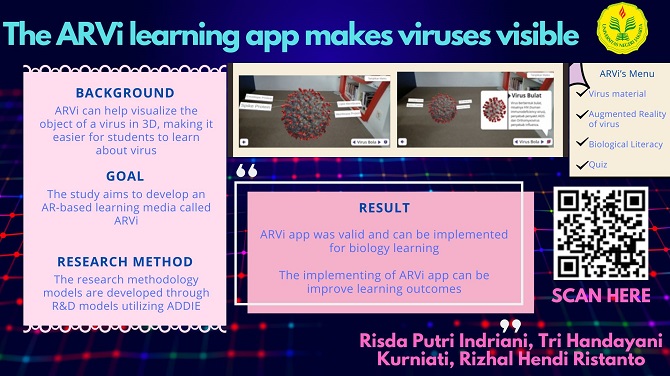
The ARVi Learning App Makes Viruses Visible
Abstract
In biology learning, the object of a virus cannot be seen directly. Augmented reality (AR) technology can help visualize the object of a virus in 3D, making it easier for students to learn about viruses. Therefore, this research aims to develop an AR-based learning media product called ARVi. ARVi was created using the ADDIE model, which consists of five stages: analysis, design, development, implementation, and evaluation. The results of the analysis revealed that students need learning media with engaging visualizations. Therefore, ARVi was designed as a mobile application with various colors, images, videos, AR, and quizzes. ARVi underwent validation tests by experts, including biology education lecturers and biology teachers. The user responses were evaluated through a small group test involving 20 students, where questionnaires were distributed. Based on the questionnaire results, the average score for the media expert was 3.84, and for the material expert was 3.80. These scores indicate that ARVi is very valid for use as a learning medium. The results of the small group test were 2.85, indicating that ARVi is valid for use after minor revisions are made. The implementation results for 60 students, as determined through a paired t-test, showed a significant difference between the pretest and posttest results, with the posttest score being higher than the pretest score. The research results concluded that ARVi is suitable as a biology learning media.
Keywords
Full Text:
Download PDFReferences
Angraini, S., Fitria, H., & Setiawan, A. A. (2021). The effect of teacher performance and learning media on learning outcomes of elementary school students. Journal of Social Work and Science Education, 2(2), 137-146.
Arslan, R., Kofoğlu, M., & Dargut, C. (2020). Development of augmented reality application for biology education. Journal of Turkish Science Education, 17(1), 62-72.
Batubara, B. M. (2021). The Problems of the World of Education in the Middle of the Covid-19 Pandemic. Budapest International Research and Critics Institute (BIRCI-Journal): Humanities and Social Sciences, 4(1), 450-457.
Budi, A. (2017). Panduan Mudah Membuat Augmented Reality. Yogyakarta: Andi.
Celik, C., Guven, G., & Cakir, N. K. (2020). Integration of mobile augmented reality (MAR) applications into biology laboratory: Anatomic structure of the heart. Research in Learning Technology, 28.
Chang, Y. H., Wu, I. C., & Hsiung, C. A. (2021). Reading activity prevents long-term decline in cognitive function in older people: evidence from a 14-year longitudinal study. International Psychogeriatrics, 33(1), 63-74.
Cimer, A. (2012). What makes biology learning difficult and effective: Students' views. Educational research and reviews, 7(3), 61.
Del Piero, H. H., Afirianto, T., & Wardhono, W. S. (2019). Pengembangan Gim Edukasi Mengenai Virus Menggunakan Teknologi Augmented Reality. Jurnal Pengembangan Teknologi Informasi Dan Ilmu Komputer, 3(10), 9533-9542.
Dewi, L. K., & Harini, N. W. (2021). Development of Digital Comics as a Media for Biology Learning of Environmental Change for Senior High School Students. Journal of Biology Education, 10(3), 296-302.
Dimon, R., Pettit, L., Cheung, C., & Quinnell, R. (2019). Promoting botanical literacy with a mobile application-CampusFlora-using an interdisciplinary, student-as-partners approach. International Journal for Students as Partners, 3(2), 118-128.
Djamahar, R., Rifan, M., & Ristanto, R. H. (2021, February). Bio-repropedia website based on reading, mapping, and sharing (RMS): A way to improve biological literacy. In Journal of Physics: Conference Series (Vol. 1796, No. 1, p. 012067). IOP Publishing.
Djati, W. R., Widiyatmoko, A., & Pamelasari, S. D. (2022, August). Penerapan Media Augmented Reality Pada Pembelajaran Ipa Untuk Melatih Kemampuan Berpikir Tingkat Tinggi Siswa. In Proceeding Seminar Nasional IPA (pp. 167-172). https://proceeding.unnes.ac.id/index.php/snipa/article/view/1350%0Ahttps://proceeding.unnes.ac.id/index.php/snipa/article/download/1350/862.
Ebbinghaus, H. (2013). Memory: A contribution to experimental psychology. Annals of neurosciences, 20(4), 155. https://www.ncbi.nlm.nih.gov/pmc/articles/PMC4117135/.
Enterprise, J. (2016). Blender untuk pemula. Jakarta: Elex Media Komputindo.
Erwinsah, R., Aria, M., & Yusup, Y. (2019, December). Application of augmented reality technology in biological learning. In Journal of Physics: Conference Series (Vol. 1402, No. 6, p. 066090). IOP Publishing.
Etobro, A. B., & Fabinu, O. E. (2017). Students’ perceptions of difficult concepts in Biology in senior secondary schools in Lagos State. Global Journal of Educational Research, 16(2), 139-147.
Firmanshah, M. I., Jamaluddin, J., & Hadiprayitno, G. (2020). Learning difficulties in comprehending virus and bacteria material for senior high schools. JPBI (Jurnal Pendidikan Biologi Indonesia), 6(1), 165-172.
Hadiprayitno, G., Muhlis, & Kusmiyati. (2019, June). Problems in learning biology for senior high schools in Lombok Island. In Journal of Physics: Conference Series (Vol. 1241, No. 1, p. 012054). IOP Publishing.
Hartono, A., Tanjung, I. F., & Syahputra, I. (2021). Virtual laboratory of Andaliman tissue culture integrated with islamic values. Biosfer: Jurnal Pendidikan Biologi, 14(2), 285-305.
Hiwari, H., Purba, N. P., Ihsan, Y. N., Yuliadi, L. P., & Mulyani, P. G. (2019, June). Kondisi sampah mikroplastik di permukaan air laut sekitar Kupang dan Rote, Provinsi Nusa Tenggara Timur. In Prosiding Seminar Nasional Masyarakat Biodiversitas Indonesia (Vol. 5, No. 2, pp. 165-171).
Indrayana, I. P. T., Manik, S. E., Lisnasari, S. F., Br, R. H., Suryaningsih, N. M. A., Marlinda, N. L. P. M., ... & Sulistyani, U. (2022). Penerapan strategi dan model pembelajaran pada Kurikulum Merdeka Belajar. Media Sains Indonesia.
Jex, M. (2002). Organizational psychology: A scientist practioner approach. USA: John Willet & Sons Inc.
Kamiana, A., Kesiman, M. W. A., & Pradnyana, G. A. (2019). Pengembangan augmented reality book sebagai media pembelajaran virus berbasis android. KARMAPATI (Kumpulan Artikel Mahasiswa Pendidikan Teknik Informatika), 8(2), 165-171.
Khade, S. N., & Khade, P. S. (2016). Diversity and statistical analysis of marine gastropod, Raigad District, Maharashtra. International Journal of Fauna and Biological Studies, 3(3), 01-04.
Laksana, R. (2018). Himpunan Lengkap Undang-Undang Republik Indonesia Tentang Guru dan Dosen. Laksana.
Lemons, P. P., & Lemons, J. D. (2013). Questions for assessing higher-order cognitive skills: It's not just Bloom’s. CBE—Life Sciences Education, 12(1), 47-58.
Liliawati, K. (2017). Peningkatan Kinerja Guru Dalam Memanfaatkan Media Pembelajaran Melalui Supervisi Akademik Bagi Guru Kelas Sd Negeri 1 Temon Semester 1 Tahun Pelajaran 2016/2017. Jurnal Mitra Swara Ganesha, 4(2).
Lyu, M. R. (2012). iDigitable. Hongkong: The Chinese University of Hongkong.
Mahmud, M. R., & Pratiwi, I. M. (2019). Literasi numerasi siswa dalam pemecahan masalah tidak terstruktur. Kalamatika: Jurnal Pendidikan Matematika, 4(1), 69-88.
Maulana, I., Harahap, R. D., & Safitri, I. (2022). Use of learning media through technology for biology education students. BIO-INOVED: Jurnal Biologi-Inovasi Pendidikan, 4(3), 282-290.
Meslilesi, M. I., Anra, H., & Pratiwi, H. S. (2017). Penerapan Augmented Reality Sebagai Media Pembelajaran Virus Dalam Mata Pelajaran Biologi Kelas X SMA (Studi Kasus: SMA Negeri 7 Pontianak). JUSTIN (Jurnal Sistem Dan Teknologi Informasi), 5(2), 80-84.
Musi, M.A., & Nurjannah. (2021). Neurosains: Menjiwai sistem saraf dan otak. Jakarta: Kencana.
Nida, H., Mursyidah, M., & Anwar, A. (2020). Rancang Bangun Aplikasi Virtual Reality Wahana Kebun Binatang. Jurnal Teknologi Rekayasa Informasi dan Komputer, 3(2).
Omurtak, E., & Zeybek, G. (2022). The effect of augmented reality applications in biology lesson on academic achievement and motivation. Journal of Education in Science Environment and Health, 8(1), 55-74.
Onel, A., & Durdukoca, S. F., (2019). Identifying the Predictive Power of Biological Literacy and Attitudes Toward Biology in Academic Achievement in High School Students. International Online Journal of Educational Sciences, 11(2).
Pelczar, M. J., & Chan, E.C.S. (1986). Elements of Microbiology. USA: McGraw-Hill Book Company.
Puspitasari, D., Praherdhiono, H., & Adi, E. (2020). Pengembangan suplemen augmented reality animation pada buku ajar biologi untuk penguatan kognitif siswa. Jurnal Kajian Teknologi Pendidikan, 3(1), 29-39.
Putrawan, G. E., & Riadi, B. (2020). Technology and language learning: English as a foreign language learners’ use of smartphones for online informal learning in Indonesia. Texto Livre, 13(3).
Ratumanan, T. G., & Laurens, T. (2011). Assessment of learning outcomes at the education unit level 2nd edition.
Resmol, K., & Leasa, M. (2022). The effect of learning cycle 5E+ Powtoon on students’ motivation: The concept of animal metamorphosis. JPBI (Jurnal Pendidikan Biologi Indonesia), 8(2), 121-128.
Riniati, W. O., Rais, R., Putri, R. S. W., Al Haddar, G., & Azis, F. (2023). Role Of School Facilities And Infrastructure On Performance Of Senior High School Teacher. Journal on Education, 5(3), 5805-5814.
Robinson, A., & Cook, D. (2018). “Stickiness”: gauging students’ attention to online learning activities. Information and Learning Science, 119(7/8), 460-468. https://doi.org/10.1108/ILS-03-2018-0014.
Roswati, N., Rustaman, N. Y., & Nugraha, I. (2019). The Development of Science Comic in Human Digestive System Topic for Junior High School Students. Journal of Science Learning, 3(1), 12-18.
Solso, R. L., Maclin, O. H., & Maclin, M. K. (2007). Psikologi Kognitif, Jakarta: Erlangga.
Suryani, F. B., Rukmini, D., Bharati, D. A. L., & Hartono, R. (2018). Promoting EFL student teachers’ life-long learning through microteaching lesson study. Celt: A Journal of Culture, English Language Teaching & Literature, 18(2), 267-281.
Susilawati, E., & Khaira, I. (2021). Web-based learning implementation to improve students' learning outcomes on understand evaluating the public policies’ impact material during the covid-19 pandemic. Nusantara Science and Technology Proceedings, 95-102.
Sweller, J. (1994). Cognitive load theory, learning difficulty, and instructional design. Learning and instruction, 4(4), 295-312. https://www.sciencedirect.com/science/article/pii/0959475294900035.
Sylvia, F., Ramdhan, B., & Windyariani, S. (2021). Efektivitas Augmented Reality Terhadap Higher Order Thinking Skills Siswa Pada Pembelajaran Biologi:(The Effectiveness of Augmented Reality Towards Students’ Higher Order Thinking Skills in Biology Subject). Biodik, 7(2), 131-142.
Thahir, R., & Kamaruddin, R. (2021). Pengaruh Media Pembelajaran Berbasis Augmented Reality (Ar) Terhadap Hasil Belajar Biologi Siswa Sma. Jurnal Riset dan Inovasi Pembelajaran, 1(2), 24-35.
Wibowo, H. S., (2023). Desain interaktif dengan Figma panduan praktis untuk pemula dan profesional. Semarang: First Publishing.
Widodo, A., & Utomo, A. B. (2021). Media Pembelajaran Taksonomi Hewan Berbasis Augmented Reality dengan Fitur Multi Target. Edu Komputika Journal, 8(1), 1-8.
Wu, H. K., Lee, S. W. Y., Chang, H. Y., & Liang, J. C. (2013). Current status, opportunities and challenges of augmented reality in education. Computers & education, 62, 41-49. http://dx.doi.org/10.1016/j.compedu.2012.10.024.
Yapici, İ. Ü., & Karakoyun, F. (2021). Using augmented reality in biology teaching. Malaysian Online Journal of Educational Technology, 9(3), 40-51.
Yussof, Y. M., Jamian, A. R., Roslan, S., Hamzah, Z. A. Z., & Kabilan, M. K. (2012). Enhancing reading comprehension through cognitive and graphic strategies: A constructivism approach. Procedia-Social and Behavioral Sciences, 64, 151-160.
DOI: https://doi.org/10.17509/jsl.v7i2.66512
Refbacks
- There are currently no refbacks.
Copyright (c) 2024 Risda Putri Indriani, Tri Handayani Kurniati, Tri Handayani Kurniati, Rizhal Hendi Ristanto, Rizhal Hendi Ristanto

This work is licensed under a Creative Commons Attribution-ShareAlike 4.0 International License.


Jl. Dr. Setiabudhi 229 Bandung 40154, West Java, Indonesia











